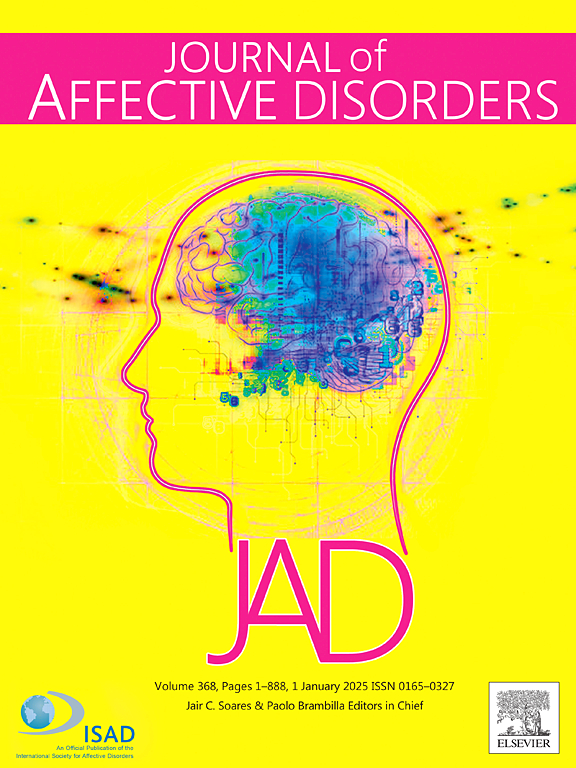Contagion of crisis: Associations between suicide attempts in the social network and suicidality among late adolescents
IF 4.9
2区 医学
Q1 CLINICAL NEUROLOGY
引用次数: 0
Abstract
Background
Adolescence is a critical developmental period for the emergence of suicidality. Exposure to suicidal behaviour within one's social network is a known risk factor, yet evidence linking such exposure to broader adolescent suicidality, including ideation, remains limited.
Aims
This study investigates the relationship between adolescent suicidality and suicide attempts in their social network, additionally focusing on the type of relationship with the individual who attempted suicide and reported deaths by suicide in adolescents' social networks.
Methods
Data were drawn from the iBerry Study, a population-based cohort oversampled for emotional and behavioural problems in the Netherlands. The sample included 769 participants (mean age 18.1 years; 46.4% male). Suicidality and suicide attempts in the social network were assessed via self-report. Binary logistic regression models adjusted for socio-demographic (age, sex, ethnic background, household income) and clinical confounders (IQ, childhood maltreatment, social support, previous suicidality) were applied.
Results
Of the participants, 30.5% reported a suicide attempt in their social network, most often by a friend or romantic partner. Reported attempts were associated with increased odds of adolescent suicidality (adjusted OR= 1.69, 95% CI 1.01–2.51, p= 0.047). However, associations with specific relationships diminished after adjustment. No differences in suicidality were found between reported fatal versus nonfatal suicide attempts.
Conclusion
Adolescents that report suicide attempts within their social network may be at heightened risk for suicidality, emphasizing the need for targeted preventive measures and interventions for vulnerable youth and addressing the broader social and relational contexts of these exposures.
危机的传染:社会网络中自杀企图与晚期青少年自杀行为之间的关系。
背景:青春期是出现自杀倾向的关键发育时期。在一个人的社交网络中接触自杀行为是一个已知的风险因素,然而,将这种接触与更广泛的青少年自杀行为(包括意念)联系起来的证据仍然有限。目的:本研究旨在探讨青少年在其社交网络中自杀倾向与自杀企图之间的关系,并着重研究青少年在其社交网络中与自杀企图者和自杀死亡报告者的关系类型。方法:数据来自iBerry研究,这是一项以人群为基础的队列,在荷兰对情绪和行为问题进行了抽样调查。样本包括769名参与者(平均年龄18.1 岁;46.4 %男性)。通过自我报告评估社交网络中的自杀倾向和自杀企图。采用经社会人口统计学(年龄、性别、种族背景、家庭收入)和临床混杂因素(智商、童年虐待、社会支持、自杀倾向)调整后的二元logistic回归模型。结果:在参与者中,30.5% %的人报告在他们的社交网络中有自杀企图,最常见的是朋友或恋人。报告的自杀企图与青少年自杀率增加有关(调整后的OR = 1.69,95 % CI 1.01-2.51, p = .047)。然而,调整后与特定关系的关联减弱。在报告的致命性和非致命性自杀企图之间,没有发现自杀行为的差异。结论:在其社交网络中报告自杀企图的青少年可能有更高的自杀风险,强调需要针对弱势青少年采取有针对性的预防措施和干预措施,并解决这些暴露的更广泛的社会和关系背景。
本文章由计算机程序翻译,如有差异,请以英文原文为准。
求助全文
约1分钟内获得全文
求助全文
来源期刊

Journal of affective disorders
医学-精神病学
CiteScore
10.90
自引率
6.10%
发文量
1319
审稿时长
9.3 weeks
期刊介绍:
The Journal of Affective Disorders publishes papers concerned with affective disorders in the widest sense: depression, mania, mood spectrum, emotions and personality, anxiety and stress. It is interdisciplinary and aims to bring together different approaches for a diverse readership. Top quality papers will be accepted dealing with any aspect of affective disorders, including neuroimaging, cognitive neurosciences, genetics, molecular biology, experimental and clinical neurosciences, pharmacology, neuroimmunoendocrinology, intervention and treatment trials.
 求助内容:
求助内容: 应助结果提醒方式:
应助结果提醒方式:


